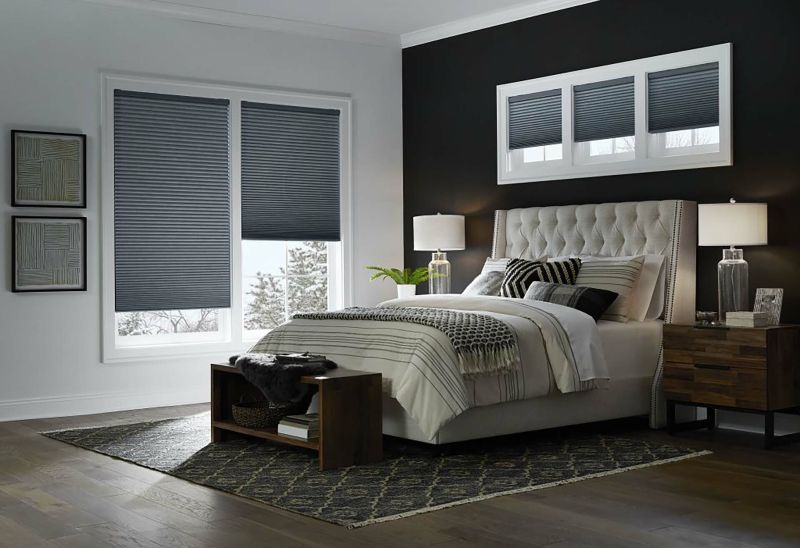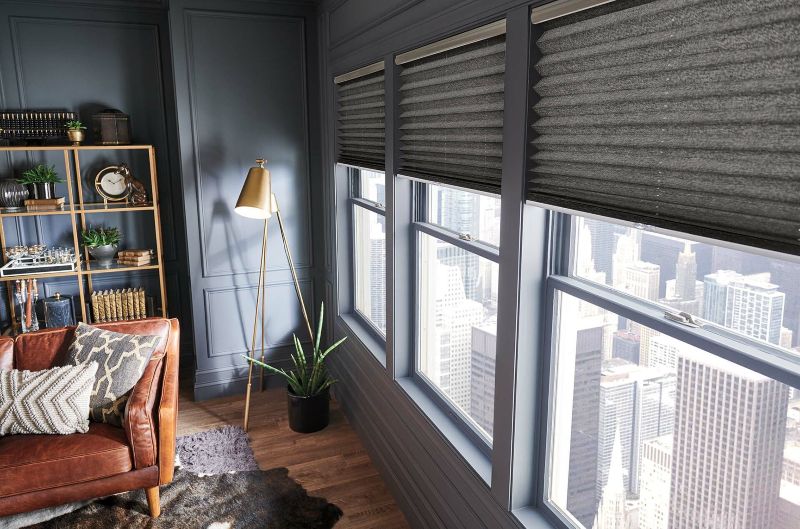How To Clean Cellular Shades?
Cleaning cellular shades can seem daunting, but maintaining these stylish window treatments is easier than one might think. Known for their energy efficiency and unique honeycomb design, cellular shades provide insulation and beauty to any room. However, they can also be magnets for dust, allergens, and even stubborn stains, making regular cleaning a must to preserve their appearance and functionality.
Whether they're light-filtering or blackout, cleaning cellular shades doesn't require harsh chemicals or expensive tools. A few simple supplies and the right techniques can keep them looking as pristine as the day they were hung. Homeowners can ensure their cellular shades continue offering beauty and performance for years by understanding the basics of proper care.

Understanding Cellular Shades
Cellular shades, popular for their unique honeycomb design, offer aesthetic appeal and practical benefits such as insulation and light control. They've become integral to modern home decor, emphasizing style and functionality.
Types and Materials
Cellular shades come in various types and materials, each suited to different needs and preferences. The choice of material affects the shades' appearance and functionality.
Single vs. Double Cell
Single-cell shades consist of one layer of cells and are typically lighter, making them easier to operate. Double-cell shades feature two layers, providing better insulation, and are ideal for extreme climates.
Light Filtering vs. Blackout
Light-filtering cellular shades allow for privacy while letting natural light in, making them perfect for areas like the living room or kitchen. If complete darkness is required, such as in bedrooms, blackout cellular shades are the best option as they prevent light from passing through.
Cordless Options
Particularly relevant to ensuring safety in homes with children and pets, cordless cellular shades offer a clean look and are simple to use. It's important to note that cleaning cordless cellular shades involves techniques similar to those used for other cellular shades, focusing primarily on gentle vacuuming and spot cleaning.
Material Choices
The most common materials for cellular shades include spun lace and bonded polyester. Spun lace is softer and less likely to fray, whereas bonded polyester is sturdier and tends to hold its shape better over time.
Selecting the right type and material for cellular shades can greatly enhance their performance and longevity. Regular maintenance and proper cleaning ensure these shades maintain their beauty and functionality, helping them stand the test of time in any home.
Essential Tools for Cleaning Cellular Shades
Cleaning cellular shades requires specific tools to ensure effectiveness while preserving their delicate structure. Proper tools simplify the cleaning process and prevent damage to the shades, maintaining their functionality and aesthetic appeal over time.
Recommended Supplies and Equipment
To properly clean cellular shades, including cordless models, a few key supplies and pieces of equipment are essential:
- Soft Brushes or a Vacuum with a Brush Attachment: Soft brushes help gently remove dust and debris without snagging the fabric. For a more thorough clean, using a vacuum cleaner equipped with a soft brush attachment ensures that dirt and dust are sucked away without harsh contact.
- Microfiber Cloths: These are ideal for wiping down the shades. Microfiber materials attract and hold dust particles with minimal lint transfer and without scratching the shade material.
- Mild Detergent and Warm Water: A mixture of mild and warm water is recommended for deeper cleaning, especially stains or built-up grime. This solution effectively cleans without degrading the shades' material.
- A Sponge or Soft Cloth: Applying a cleaning solution with a sponge or a soft cloth can ensure an even and gentle application, preventing saturation and potential water damage.
- Hair Dryer (Optional): After cleaning, a hair dryer set on a cool setting can quickly dry the shades. This step is crucial to avoid water spots and maintain the fabric's integrity.
When executing these methods, particularly for cordless cellular shades, it’s vital to use even pressure and avoid pulling or stretching the material. This maintains the shades' smooth operation and beautiful appearance. Each tool is crucial in cellular shades' regular maintenance and longevity, ensuring they remain functional and stylish in any space.
Routine Cleaning of Cellular Shades
Maintaining the pristine condition of cellular shades requires regular and careful cleaning. This section outlines the best practices for routine cleaning without harming the shades’ structure and aesthetics.
Dusting Techniques
Dusting is the first step in the cleaning routine to remove surface dust and prevent accumulation. One should use a feather duster or a soft dusting mitt for effective dust removal. Holding the duster lightly, one begins at the top and moves gently downwards sweepingly. This technique ensures that dust does not settle further into the fabric but is collected or removed. Minimizing pressure is crucial for cordless cellular shades to avoid displacing them from their mounts.
Vacuuming Tips
When more thorough cleaning is necessary, vacuuming provides a deeper clean without the need for water or harsh cleaning agents. One should attach the soft brush accessory to the vacuum cleaner to safely dislodge and remove dust from the delicate fabric. It's recommended to set the vacuum to a low suction level to prevent damage to the cellular structure. Vacuuming should follow a horizontal pattern across each cell to ensure even coverage. This method is especially beneficial for shades in high-traffic areas where dust and allergens accumulate more frequently.
By incorporating these gentle yet effective dusting and vacuuming techniques, one can extend the life and maintain the aesthetic quality of cellular shades.
Spot Cleaning and Stain Removal
When spot cleaning and stain removal from cellular shades, it’s essential to adopt a cautious and precise approach to prevent damage. This section provides step-by-step guides for effectively tackling stains.
Best Practices for Handling Stains
To promptly address stains on cellular shades, first start by identifying the stain type. Water-based stains, such as those from drinks, typically require a damp microfiber cloth for removal. A mild detergent solution mixed with warm water proves effective for oil-based stains like fingerprints or kitchen grease.
Prepare the Cleaning Solution
Mix a teaspoon of mild detergent with a quart of warm water. Stir gently to combine. This mild solution cleanses without harming the delicate fabric of the shades.
Blot, Don't Rub
Apply the cleaning solution using a clean, soft cloth. Blot the stain rather than rub it; rubbing can push it deeper into the fabric and cause permanent marks.
Rinse with Care
After treating the stain, dab the area with a cloth dampened in clean water to remove any soap residue. Over time, residue can attract more dirt.
Dry Gently
Post-rinsing, pat the area with a dry towel and let it air dry completely. If necessary, a cool hairdryer can speed up the drying process, held at a safe distance to avoid heat damage.
Test First
Before applying any solution, test it on a small, inconspicuous shaded area. This ensures compatibility and prevents unwanted discoloration or damage.
Adhering to these methods effectively removes stains while maintaining the beauty and longevity of cellular shades. Whether the shades are cordless or otherwise, this gentle approach ensures they remain clean, functional, and visually appealing.
Deep Cleaning Methods
Deep-cleaning cellular shades can rejuvenate them and enhance their longevity. This section explores efficient methods for deep cleaning, ensuring homeowners maintain their shades' pristine condition.
Using the Bathtub for Soaking
To thoroughly clean heavily soiled cellular shades, fill a bathtub with lukewarm water and a small amount of mild detergent, ensuring it forms suds. Fully immerse the shades in this mixture, removing them from their fittings beforehand. Allow them to soak for no less than 15 minutes but no more than 30 minutes to avoid damage. Gently swish the shades in the water to loosen dirt. Afterward, drain the tub and rinse the shades in clean water to remove soap residue. Support the shades carefully when removing them from water to prevent stretching. Let the shades air-dry completely in a well-ventilated area, or use a hair dryer in a cool setting. This cleaning method is especially suitable for cordless cellular shades since it avoids disassembly.
Professional Cleaning Options
Professional cleaning is recommended for cellular shades with stubborn stains or made from delicate materials. Professional cleaners are equipped with specialized techniques, advanced cleaning solutions, and equipment capable of deep cleaning while protecting the fabric's integrity and color. These services provide the added convenience of handling the removal and reinstallation of the shades, ensuring the delicate mechanisms, especially in cordless shades, are not damaged. Opting for experts in window treatments can also extend the life and appearance of the shades, saving time and preserving their quality.
By selecting either method—soaking in a bathtub or professional cleaning—homeowners can effectively manage deep cleaning of their cellular shades, ensuring they remain a beautiful and functional part of their living space.
Maintenance and Care Tips
Regular maintenance and diligent care can extend the life and beauty of cellular shades. Addressing cleaning needs proactively minimizes the effort required over time.
Preventative Measures to Keep Shades Cleaner Longer
Adopting preventive measures to keep cellular shades clean and extend their lifespan is advisable. Regular dusting, at least once a month using a soft brush attachment on a vacuum, is crucial, especially for delicate shades like cordless ones. Positioning shades in low-traffic areas minimizes exposure to dirt, but if they must be in high-traffic areas, more frequent vacuuming is necessary. Applying fabric protectant sprays can also help by creating a dirt-repelling barrier. However, it's important first to test the spray on a small section to check for any adverse effects on the material. These steps reduce the need for deep cleaning and keep the shades in optimal condition.
Common Cleaning Mistakes to Avoid
When maintaining cellular shades' aesthetic appeal and functionality, certain cleaning missteps can undermine their longevity and appearance. Avoiding these common mistakes ensures that shades remain in top condition without requiring frequent deep cleaning or professional restoration.
Using Harsh Chemicals
Harsh cleaning agents can cause discoloration and damage cellular shades' fabric. If you're inclined to reach for powerful solvents or bleach, reconsider. Shades fare better with milder soap solutions or specialized cleaners recommended by the manufacturer.
Excessive Water Use
Applying too much water can deform the structure of cellular shades, especially those not designed to handle heavy moisture. Rather than soaking the shades entirely, it is advisable to use a slightly damp cloth for spot cleaning. Overwetting can lead to unsightly water stains or even mildew buildup.
Neglecting Regular Dusting
Regular maintenance, like monthly dusting with a soft brush vacuum attachment, is crucial in maintaining cellular shades. Neglect can lead to excessive dirt accumulation, making deeper cleaning necessary more often.
Scrubbing Vigorously
Scrubbing cellular shades vigorously can stretch or tear the delicate fabric. A gentle hand is essential, using soft cloths or sponges to dab at stains lightly. This method protects the integrity of the shades while effectively addressing spots.
Ignoring Manufacturer’s Instructions
Ignoring the cleaning guidelines provided by the shades' manufacturer can lead to permanent damage. These instructions are tailored to the shades' material and design and offer the safest cleaning methods for specific products.
By avoiding these errors, homeowners safeguard their investment and maintain the beauty and function of their cellular shades longer. Regular adherence to proper cleaning minimizes the need for professional intervention, saving time and money while ensuring the shades look their best.

Conclusion
Properly caring for cellular shades isn't just about keeping them looking pristine—it's also about extending their lifespan and functionality. Adopting the right cleaning habits ensures that these window treatments continue to offer both beauty and efficiency in regulating home temperatures. By integrating gentle cleaning techniques and regular maintenance into your routine, homeowners can avoid the pitfalls of common cleaning errors. Remember that the longevity of your cellular shades largely depends on the care they receive. So take a moment to treat them well; they'll continue to brighten and insulate your space for years.



